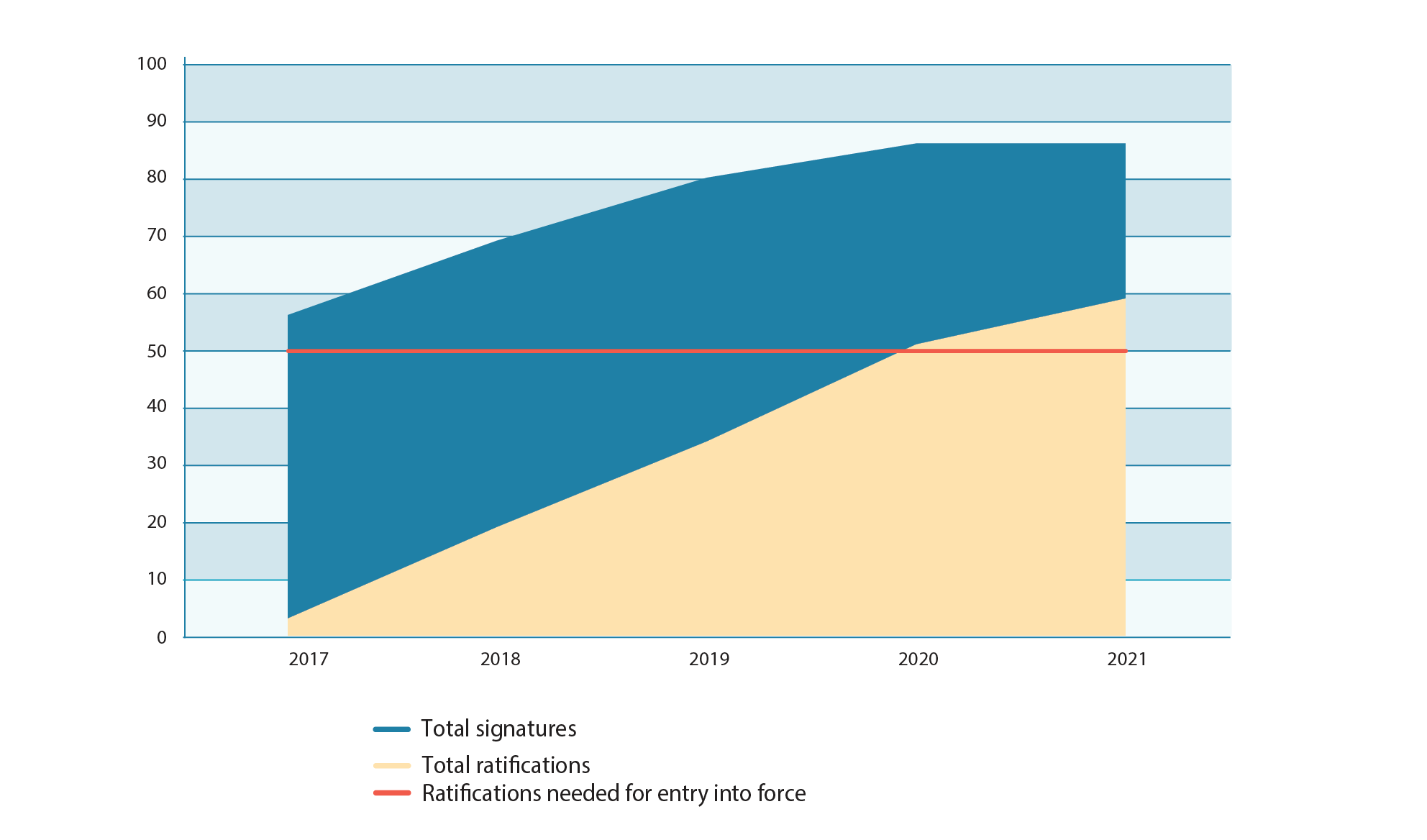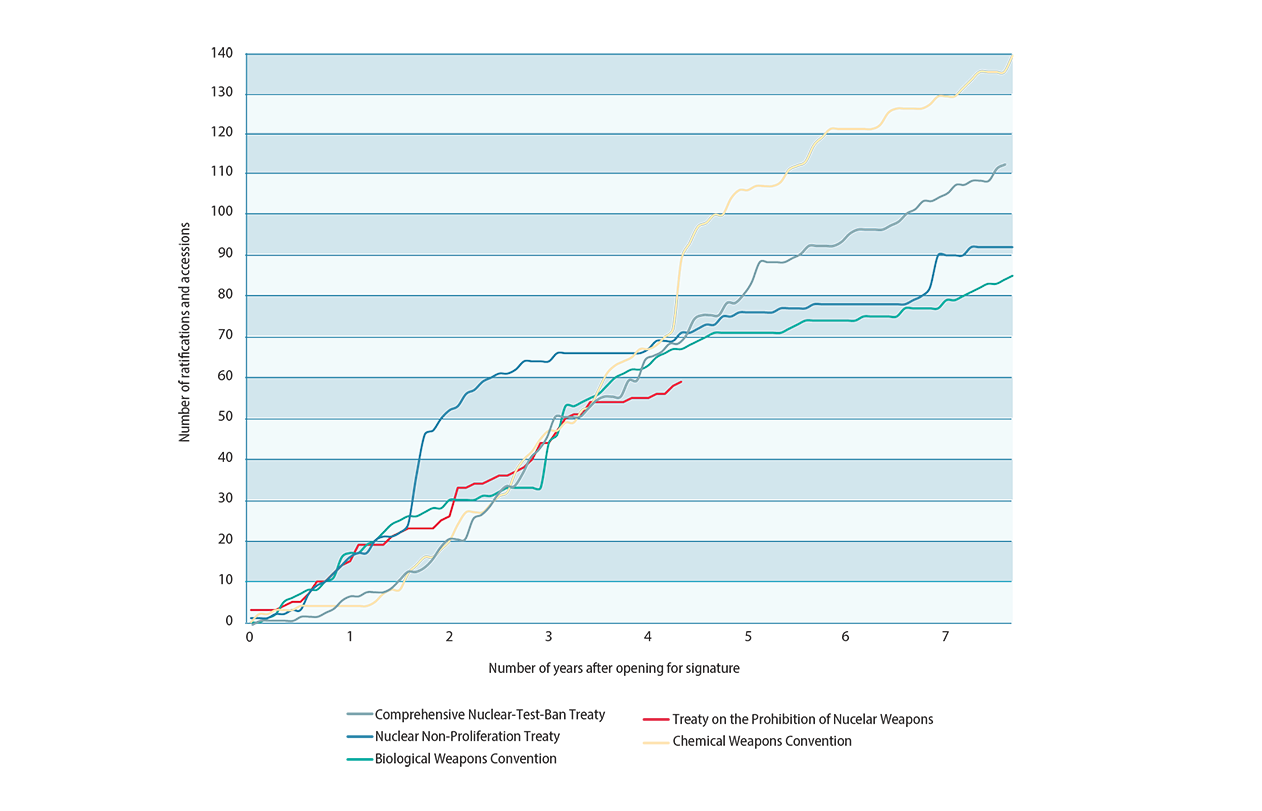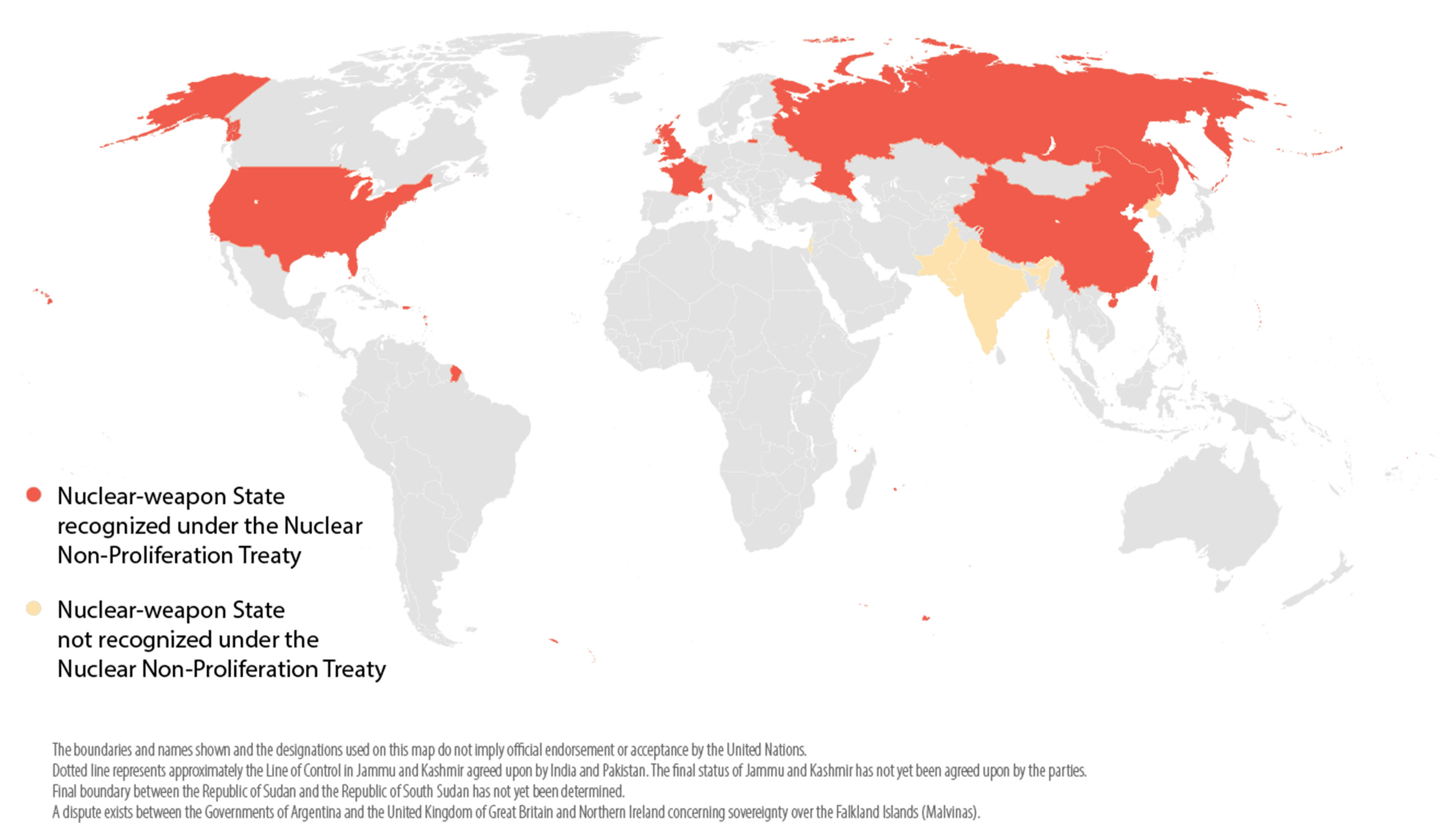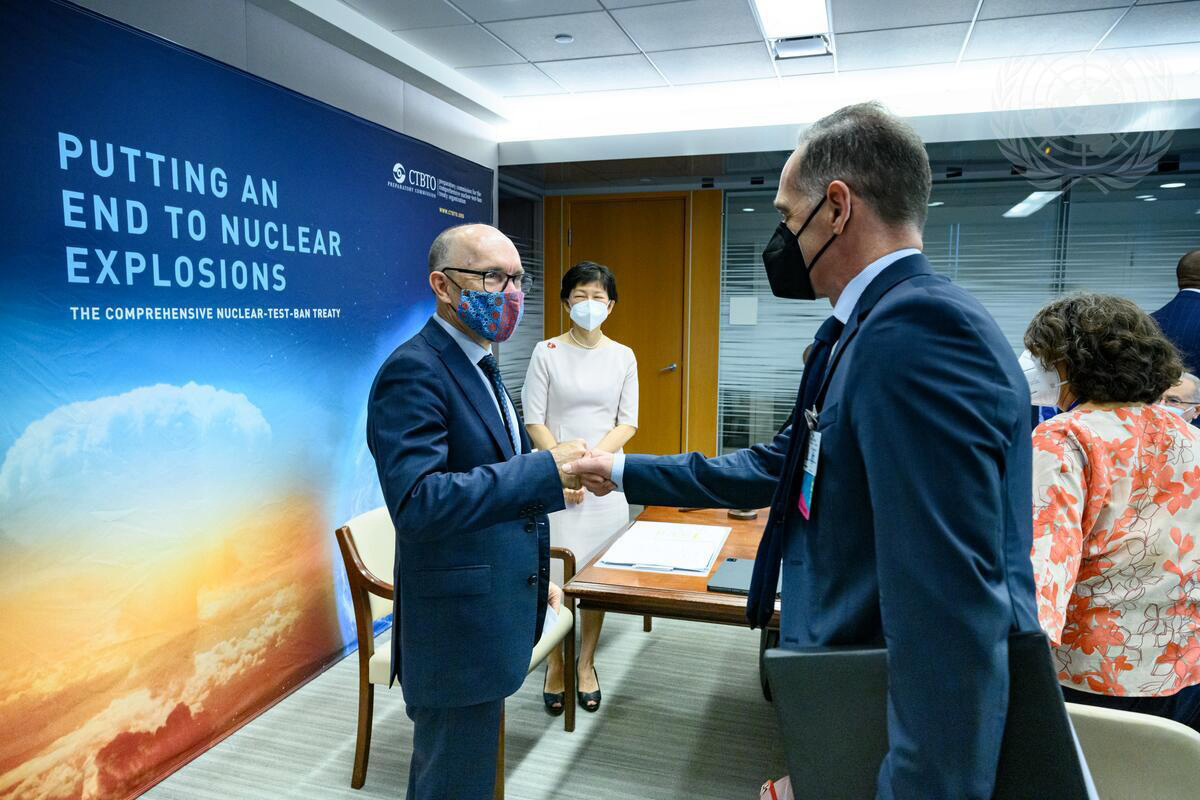Nuclear conflict has no victors. Only victims.
On 24 January, the United Nations commemorated the seventy-fifth anniversary of the very first General Assembly resolution (1/1) on establishing a Commission that would make specific proposals “for the elimination from national armaments of atomic weapons”, among other aims. To mark the occasion, the High Representative for Disarmament Affairs, Izumi Nakamitsu, called on all States to “finish the task begun in 1946” and establish a world free of nuclear weapons.
Fittingly, the commemoration occurred through two important events related to that goal.
The first of those events, on 22 January, was the entry into force of the Treaty on the Prohibition of Nuclear Weapons, the first comprehensive prohibition on the use and possession of nuclear weapons for States that choose to join it. Conditions for the Treaty’s entry into force had been met in October 2020, with the deposit of the fiftieth instrument of ratification. As at the end of 2021, the Treaty had 59 States parties and 86 signatories. The Treaty’s adoption in 2017 had made it the first new multilateral legal instrument on nuclear disarmament since 1996, and the Secretary-General greeted its entry into force as “an important step towards the goal of a world free of nuclear weapons and a strong demonstration of support for multilateral approaches to nuclear disarmament”. He commended the States that had ratified the Treaty while welcoming the instrumental role of civil society in advancing the agreement’s negotiation and entry into force.

Following its adoption in 2017, the Treaty on the Prohibition of Nuclear Weapons acquired, on 24 October 2020, the 50 ratifications necessary for its entry into force. With its entry into force on 22 January 2021, the Treaty became part of the broader nuclear disarmament and non-proliferation framework. As at the end of 2021, 59 States had ratified or acceded to the Treaty and 86 had signed it.
The second key event, on 3 February, was the extension of the Treaty between the United States of America and the Russian Federation on Measures for the Further Reduction and Limitation of Strategic Offensive Arms (New START Treaty). The Treaty was extended for the maximum five years allowed under its terms, keeping in place the last bilateral nuclear arms control agreement and providing verifiable limits on the world’s largest strategic nuclear forces until 5 February 2026. Following the summit in Geneva on 16 June, the presidents of the United States and the Russian Federation announced an “integrated bilateral Strategic Stability Dialogue in the near future” that would seek to lay the groundwork for new measures for arms control and risk reduction. The leaders also reaffirmed their commitment to the principle that a nuclear war cannot be won and must never be fought.

This chart shows the pace of States’ ratification of and accession (as at December 2021) to the major instruments related to the elimination and non-proliferation of weapons of mass destruction (nuclear, chemical and biological weapons) following their opening for signature. The graph shows a rough similarity between the instruments until the 4.5-year mark. The lower rate of adherence for the Treaty on the Prohibition of Nuclear Weapons at that point is likely owing to the COVID-19 pandemic.
Source: Nuclear Weapons Ban Monitor (produced and published by Norwegian People’s Aid)
The High Representative for Disarmament Affairs welcomed both the extension of the New START Treaty and the resumption of dialogue on strategic stability between the Russian Federation and the United States. Speaking later in the year, she said the Treaty’s five-year extension “provides a ticking clock for both sides”. In that regard, she expressed hope that the two countries would “use the time before the Treaty’s expiration to lay the ground for the next generation of arms control”.
Unfortunately, those developments were rare highlights in a year that otherwise saw a heightened risk of nuclear-weapon use amid rising pressure on the global nuclear disarmament and non-proliferation regime.
Relationships between States possessing nuclear weapons deteriorated throughout the year as tensions grew at regional flashpoints, creating new possibilities for escalation. In parallel, concerns about the potential for a nuclear accident or miscalculation multiplied amid growing military activity related to new domains such as cyber- and outer space, as well as new investments in conventional weapons systems with potential strategic capabilities. As the Secretary-General said on the occasion of the 2021 International Day for the Total Elimination of Nuclear Weapons, “Tensions remain elevated. Trust is in short supply. And in this unstable environment, the chance of misunderstandings, miscalculations and malfunctions is frighteningly high. Nuclear risk has reached levels not seen in almost four decades.”
While the five nuclear-weapon States continued to express their support for a world free of nuclear arms, they also continued to modernize their arsenals in ways intended to qualitatively improve their reliability, accuracy, speed and stealth. Furthermore, allegations of a quantitative stockpile expansion by China and plans by the United Kingdom to raise the maximum potential size of its nuclear arsenal signalled that the gradual reduction in the total number of nuclear weapons over the previous three decades was potentially ending. As the United States announced that it would again make public its number of nuclear weapons, reversing a 2017 policy change and boosting the transparency of its stockpile, the United Kingdom chose to end its long-running practice of releasing that information.
Other notable developments concerning the nuclear-weapon States included independent reports that China had fielded two new brigades of its nuclear-capable DF-41 road-mobile intercontinental ballistic missile, commissioned two additional ballistic missile submarines, continued the development of a new type of submarine and reassigned a formal nuclear mission to its bomber aircraft. In June, multiple non-governmental organizations assessed from publicly available satellite imagery that China was increasing its number of ballistic missile siloes by several hundred, prompting allegations that it was rapidly expanding its nuclear arsenal to have 700 deployed nuclear warheads by 2027 and 1,000 by 2030. China also allegedly tested a nuclear-capable hypersonic glide vehicle launched from a fractional orbital bombardment system. In response to those allegations, China reiterated its decades-old commitments to maintain a credible minimum deterrent and follow a no-first-use policy for nuclear weapons.
In March, the newly elected President of the United States, Joseph R. Biden, Jr., stated that his administration would “re-establish … credibility as a leader in arms control” and “take steps to reduce the role of nuclear weapons in our national security strategy, while ensuring our strategic deterrent”. As his administration commenced the development of a new Nuclear Posture Review, due for completion in early 2022, it requested a budget of $43.2 billion to continue with plans to replace the United States’ land-based intercontinental ballistic missiles, air-launched cruise missiles and nuclear-capable bombers and submarines, as well as to modify or replace nuclear warheads.
The Russian Federation, for its part, continued to modernize its nuclear warheads and delivery systems, including its intercontinental ballistic missile force. The President of the Russian Federation, Vladimir Putin, had estimated that, by the end of 2021, modernized weapons would comprise some 88.3 per cent of his Government’s nuclear forces. The Russian Federation also tested new long-range cruise missiles and a hypersonic missile while continuing to develop weapons systems announced by President Putin in 2018.
In recent years, States possessing nuclear weapons have stepped up nuclear modernization efforts, resulting in the development of new weapon systems, qualitative improvement of existing systems and the development of new nuclear-capable platforms. It has been argued that the modernization programmes of the five nuclear-weapon States identified in the Nuclear Non-Proliferation Treaty are inconsistent with commitments undertaken as parties to the Treaty.

China’s modernization programme is marked by investment in and expansion of its nuclear force capability, including significant investment in land, sea and air-based delivery platforms. The construction of updated Type 096 nuclear-powered ballistic-missile submarines, which will reportedly be armed with JL-3 submarine-launched ballistic missiles, was believed to have started in early 2021. It also reportedly deployed at least two brigades of the DF-41 road-mobile intercontinental ballistic missile. In June, multiple non-governmental organizations, using publicly available satellite imagery, reported that China was increasing the number of its ballistic missile siloes by several hundred, prompting allegations that China was rapidly expanding its strategic nuclear arsenal. China has refuted those allegations. ’s modernization programme is marked by investment in and expansion of its nuclear force capability, including significant investment in land, sea and air-based delivery platforms. The construction of updated Type 096 nuclear-powered ballistic-missile submarines, which will reportedly be armed with JL-3 submarine-launched ballistic missiles, was believed to have started in early 2021. It also reportedly deployed at least two brigades of the DF-41 road-mobile intercontinental ballistic missile. In June, multiple non-governmental organizations, using publicly available satellite imagery, reported that China was increasing the number of its ballistic missile siloes by several hundred, prompting allegations that China was rapidly expanding its strategic nuclear arsenal. China has refuted those allegations.
The Democratic People’s Republic of Korea continued its development and testing of various delivery systems, and it carried out several launches using ballistic missile technology.
France is continuing its planned modernization campaign featuring new submarine-launched ballistic missiles, third-generation ballistic-missile submarines and refurbishment of ASMP-A air-launched cruise missiles. Pursuant to the Military Programming Law for 2019–2025, the defence budget has also increased by €1.7 billion to a new total of €40.9 billion for 2022.
India’s nuclear forces were expanded and improved in 2021, including testing of improved missile systems such as the Agni-P medium-range ballistic missile. The test of the Agni-P missile in December showed new usage of canisterization, improving the readiness of the nuclear forces of India.
Although Israel is alleged to possess nuclear weapons, it neither confirms nor denies its nuclear status.
Pakistan aims to increase its delivery capabilities for both ballistic and cruise missiles. It continues to develop variants of the Babur cruise missile, including the Babur-1A, tested in February, and the Babur-1B, tested in December 2021.
The Russian Federation has recapitalized 89 per cent of its cold war-era strategic nuclear forces, expanding its warhead delivery capacity by introducing systems such as the Avangard hypersonic glide vehicle, further increasing the number of aircraft equipped with the Kinzhal air-launched hypersonic missile and investing in hypersonic weapons such as the Tsirkon, which was successfully test fired from both a submarine and a frigate in late December. The new RS-28 “Sarmat” silo intercontinental ballistic missile has also entered late-stage testing and is expected to be put on active duty in 2022.
The United Kingdom remains on track for the development of four Dreadnought-class ballistic missile submarines to replace the Vanguard-class submarines in accordance with their “once-in-two-generations” modernization programme. That also includes plans to replace nuclear warheads to guarantee an effective deterrent during the commissioning of the Dreadnought-class submarines. The United Kingdom raised the ceiling of its overall nuclear-weapon stockpile to no more than 260 warheads, a departure from the previous cap of 180 warheads.
The United States’ nuclear modernization is continuing as planned with efforts across its entire nuclear triad, including development of the Ground-Based Strategic Deterrent to replace the Minuteman III intercontinental ballistic missile. The Congressional Budget Office of the United States estimated that plans for nuclear forces would cost $634 billion over the 2021–2030 period, which was $140 billion or 28 per cent more than the 2019 estimate. The National Defense Authorization Act for 2022 approved a $5.2 million budget for development of a low-yield sea-launched cruise missile (SLCM-N) and established that the National Nuclear Security Agency funds should not be used to retire or reconvert the debated W76-2 warhead.
The year saw improved prospects for resolving the long-standing fears of regional proliferation tied to the nuclear programme of the Islamic Republic of Iran. In April, the remaining parties to the Joint Comprehensive Plan of Action and the United States met in Vienna to discuss a return to full and effective implementation of the Plan by all relevant parties. Significant progress had been achieved after seven rounds of talks held throughout the year. Key divergences remained, however, notably concerning the sequencing of sanctions relief by the United States and of a return to compliance by the Islamic Republic of Iran, as well as the issue of a possible second withdrawal by the United States.
Throughout 2021, the International Atomic Energy Agency (IAEA) continued to report that the Islamic Republic of Iran was engaged in activities inconsistent with the Plan of Action, as reflected in announcements by its Government since 2019 and a law that its Parliament had passed in 2020. Those activities included experimenting with advanced centrifuges, producing uranium metal, stockpiling enriched uranium and enriching uranium to levels well above those allowed under the Plan. In parallel, the Islamic Republic of Iran announced that it would no longer allow verification measures beyond those required under its IAEA Comprehensive Safeguards Agreement, prompting an IAEA warning that such moves would have “a serious impact on the Agency’s ability to report on the implementation of Iran’s commitments and undermine the critical confidence in the peaceful nature of Iran’s nuclear programme”.
On 15 September, Australia, the United Kingdom and the United States announced the creation of the “AUKUS” security partnership, along with its first project: supplying Australia with a nuclear-powered, conventionally armed submarine fleet that Australia would construct domestically. The project would mark the first case of a nuclear-weapon State providing a non-nuclear-weapon State with the technology to build its own nuclear-powered submarines. Furthermore, as Australia had no domestic uranium enrichment or reprocessing capability, highly enriched uranium to power the submarines would need to be provided by either the United Kingdom or the United States. All three States noted that the arrangement was allowed under the Comprehensive Safeguards Agreement of Australia, and they pledged to support IAEA in verifying the non-diversion of nuclear material for use in weapons. Nonetheless, critics charged that the agreement set a dangerous precedent that would allow highly enriched uranium to be removed from the Agency’s view for use in submarine propulsion.
Meanwhile, the COVID-19 pandemic continued to constrain activities related to the global nuclear disarmament and non-proliferation regime. Public health risks from the pandemic forced two further postponements of the tenth Review Conference of the Parties to the Treaty on the Non-Proliferation of Nuclear Weapons (Nuclear Non-Proliferation Treaty). States parties’ inability to hold the Review Conference placed significant pressure on that international regime, given the Conference’s role as the de facto forum for conducting multilateral dialogue on all issues related to nuclear weapons. Such engagement can help States to delineate new measures for reducing nuclear risk and strengthening frameworks for nuclear disarmament and non-proliferation.
States continued endeavouring to adapt to the pandemic’s challenges. By its decision 76/515 of December 2021, the General Assembly requested the Secretary-General to hold two additional sessions of the Group of Governmental Experts to Further Consider Nuclear Disarmament Verification Issues in Geneva in 2023, compensating for the postponement of two sessions previously planned for 2021. Likewise, the Assembly called for one additional informal, intersessional consultative meeting to be held in New York in 2023, to compensate for a planned 2021 meeting that had to be postponed owing to the pandemic.
Cognizant of the urgent need to reverse the trend of rising nuclear risk and set the world back on a path to the elimination of nuclear weapons, the Secretary-General proposed the development of a “new agenda for peace” partly to increase support for nuclear non-proliferation and a world free of nuclear weapons, as well as establish stronger commitments for the non-use of nuclear weapons and a time frame for their elimination. In his new report entitled Our Common Agenda, the Secretary-General expressed hope that such efforts could help advance the vision outlined in his 2018 Agenda for Disarmament.

At the high-level international Conference on Facilitating the Entry into Force of the Comprehensive Nuclear-Test-Ban Treaty, held on 23 September 2021, Robert Floyd (left), Executive Secretary of the Preparatory Commission for the Comprehensive Nuclear-Test-Ban Treaty Organization, greets Heiko Maas, Federal Minister for Foreign Affairs of Germany (also present is Izumi Nakamitsu (centre), High Representative for Disarmament Affairs). UN Photo/Loey Felipe